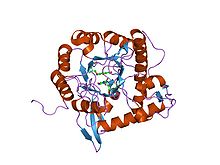Inosine monophosphate dehydrogenase
| IMP dehydrogenase | |||||||||
|---|---|---|---|---|---|---|---|---|---|

Structure of IMPDH
|
|||||||||
| Identifiers | |||||||||
| EC number | 1.1.1.205 | ||||||||
| CAS number | 9028-93-7 | ||||||||
| Databases | |||||||||
| IntEnz | IntEnz view | ||||||||
| BRENDA | BRENDA entry | ||||||||
| ExPASy | NiceZyme view | ||||||||
| KEGG | KEGG entry | ||||||||
| MetaCyc | metabolic pathway | ||||||||
| PRIAM | profile | ||||||||
| PDB structures | RCSB PDB PDBe PDBsum | ||||||||
| Gene Ontology | AmiGO / EGO | ||||||||
|
|||||||||
| Search | |
|---|---|
| PMC | articles |
| PubMed | articles |
| NCBI | proteins |
| IMP dehydrogenase 1 | |
|---|---|
| Identifiers | |
| Symbol | IMPDH1 |
| Alt. symbols | RP10 |
| Entrez | 3614 |
| HUGO | 6052 |
| OMIM | 146690 |
| RefSeq | NM_000883 |
| UniProt | P20839 |
| Other data | |
| EC number | 1.1.1.205 |
| Locus | Chr. 7 q31.3-q32 |
| IMP dehydrogenase 2 | |
|---|---|
| Identifiers | |
| Symbol | IMPDH2 |
| Alt. symbols | IMPD2 |
| Entrez | 3615 |
| HUGO | 6053 |
| OMIM | 146691 |
| RefSeq | NM_000884 |
| UniProt | P12268 |
| Other data | |
| EC number | 1.1.1.205 |
| Locus | Chr. 3 p21.2 |
IMP dehydrogenase EC 1.1.1.205 (Inosine-5'-monophosphate dehydrogenase) (Inosinic acid dehydrogenaseis) (IMPDH) an enzyme that converts inosine monophosphate to xanthosine monophosphate:
It catalyzes the rate-limiting reaction of de novo GTP biosynthesis.
IMP dehydrogenase is associated with cell proliferation and is a possible target for cancer chemotherapy. Mammalian and bacterial IMPDHs are tetramers of identical chains. There are two IMP dehydrogenase isozymes in humans. IMP dehydrogenase nearly always contains a long insertion that has two CBS domains within it.
The structure of this enzyme is composed of a TIM barrel domain with two CBS domains inserted within a loop.
It is inhibited by Mycophenolic acid, ribavirin, and 6TGMP (6-thioguanine monophosphate). 6TGMP inhibition prevents purine interconversion and thus the synthesis of purine nucleotides.
Humans express the following two IMP dehydrogenase isozymes:
This article incorporates text from the public domain Pfam and InterPro IPR001093
...
Wikipedia
